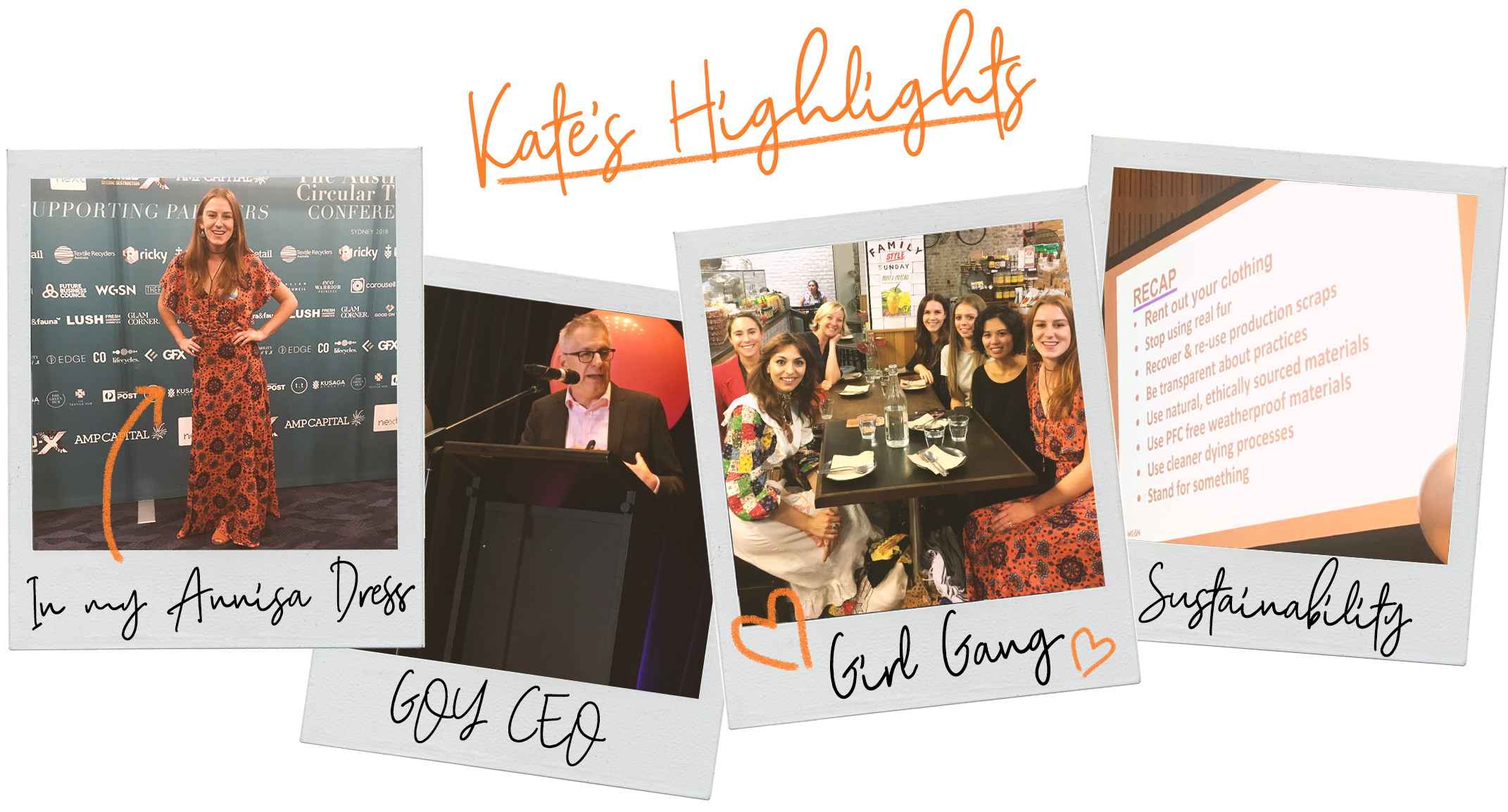You know when you decide against something, but then it haunts you for days after? This was the roundabout way I decided to attend Australia's first Circular Fashion Conference, and thank goodness I did.
On the 22nd of March, 2018, I found myself surrounded by some of the greatest minds in Australian fashion, small brands, big brands, bloggers and influencers, fashionistas, business men and women, spectators, listeners, and everyone in between. It's been over a week since the event, but I'm still coming down from my sustainable fashion high.
The conference aimed at starting conversations around circular fashion, and ultimately sharing education by hearing from some of the most influential individuals and groups in the retail fashion industry. Circular fashion describes a model where we see clothes recycled at the end of their life span. Currently, it's nearly 100% linear, and that's not sustainable for our world. Everyone at the conference was there to change and challenge the linear model, and I believe we made some steps in the right direction.
The day involved guest speakers, networking, interactive activities, and insightful round table sessions where we locked heads to work out how to 'save the world'.
The conference left me with a whirlpool of thoughts; I'm still attempting to pin them down. Here's some insight into my whirlpool…
Fashion Can Change the World
Anyone who tells you they don't believe fashion can make change, can be proven wrong in an instant. Patrick Duffy, founder of Global Fashion Exchange discussed the importance of fashion in society. Fashion isn't a frivolous industry that only those with spare time or raging egos partake in. We enter the fashion industry from the day we are born. Fashion is how people define themselves, regardless of their conscious decision to care or not. Therefore, we can use fashion as a global tool for change.
Fashion is uplifting for ourselves, the people around us, and the people who make it. Being one of the largest industries in the world, there's no doubt fashion can change the world.
The Gap Between What We Say and What We Do
Gordon Renouf, co-founder of Good on You, held the room's attention as he talked about a topic we were all eager to learn about. It is widely known that the gap between what we say and what we do is one of the biggest issues in the fashion industry. Consumers may say they'll pay extra for ethical fashion, but do they in reality?.
Gordon went on to highlight the reason behind Good on You; an app which rates brands according to their environmental, labour, and animal standards. Consumers have the right to know the background of their goods. With over 120,000 monthly users, 1300 brand users, and 60 retail consumers, Good on You is striving to bridge the gap, but it's only just the beginning.
Fashion Has Stopped Communicating
Fashion has stopped communicating. Wendy Cameron, consultancy expert, uttered these words on the 22nd of March, and they've been playing on my mind ever since. To me, they feel like the answer to so many questions. Due to globalisation, the fashion industry no longer involves just a textile supplier and the seamstress down the street. So many different hands, machines, and companies are involved in the creation of a single garment. The value of good information - from raw material to consumer purchase - cannot be understated.
Think about it. Full transparency means consumers get to decide which products to support based on their values. Given clear information, a consumer will know what type of practices they are or are not supporting.
Fashion needs to start communicating.
Change is Happening, We Just Aren't Talking About It
When I stepped into the conference centre, I was ready to face retail representatives with questions, harsh words, and a tough skin. But I left with a strong sense of hope, and a desire to build them up. Chris Nunn, AMP Capital Head of Sustainability, was the first to highlight how much I didn't know, and still don't know.
Chris detailed all the changes and initiatives they are implementing in the shopping mall real estate industry across Australia and New Zealand. He described their new packaging standards, charitable giving, sustainable design features, and passion for retail environments that gave back to the planet, instead of took from it. I had no idea! Me, Kate, involved in the ethical fashion sector all day every day, had never heard of it. My question was, why are they all staying quiet?
During the round tables, we heard from other people in the group who came from a mix of different brands and backgrounds. Representatives from Kmart spoke up about their sustainability initiatives in their packing and delivery factories, and it turns out Bonds does funky things with recycling their garment hangers too. The rest of the group were baffled that they keep this all secret from the public. But the brand reps explained; if they share one good thing they are doing in terms of sustainability, they are slammed for the thousands of things they aren't doing.
Yes, they aren't perfect, but if they spend all their time consulting the media and covering up their bad exposure, they'll have no time to work on improvements. It's issues like this we need to work through which is why my perception of large brands has evolved to be more understanding.
As you can tell, I could talk about this for days. The Australia Circular Fashion Conference was the first of its kind, but it surely won't be the last. Watch out.







Leave a comment